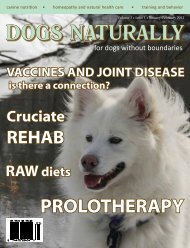January/February 2011 - Dogs Naturally Magazine
January/February 2011 - Dogs Naturally Magazine
January/February 2011 - Dogs Naturally Magazine
Create successful ePaper yourself
Turn your PDF publications into a flip-book with our unique Google optimized e-Paper software.
Toxic Pesticides<br />
Reversing The Damage<br />
by: Deva Khalsa VMD<br />
The advent of easy to use spot-on products has made flea and<br />
tick prevention convenient for many pet owners. Certain ticks<br />
can carry dangerous diseases so we’ve all become extra careful<br />
with our prevention routine.<br />
As a veterinarian, I’ve been taught that the majority of these<br />
products are harmless and safe, but evidence now shows that<br />
both the ‘active’ and some ‘inactive’ ingredients in the spot- on<br />
preparations have been linked to serious health effects both in laboratory<br />
animals and in pets.<br />
The Washington-based Center for Public Integrity (CPI), a nonprofit<br />
investigative news organization, and the National Resources Defense<br />
Council, an environmental advocacy group, have both published reports<br />
about the safety of prescription and over-the-counter flea and<br />
tick treatments.<br />
Dr. Dobozy of the EPA’s Pesticide Division has found that the active<br />
ingredient (fipronil) in Frontine remains in a pet’s system with the<br />
potential for nervous system and thyroid toxicity. Tests on laboratory<br />
animals resulted in thyroid cancer and altered thyroid hormones,<br />
liver and kidney toxicity, reduced fertility and convulsions. Frontline’s<br />
web site creates the impression that the product stays in the oil<br />
glands of the skin. But Dr. Dobozy’s study showed that, in fact, it<br />
does enter the body and the organ systems.<br />
Advantage contains the active ingredient Imidacloprid. In laboratory<br />
studies Imidacoprid has been found to increase cholesterol levels<br />
in dogs, cause thyroid lesions, create liver toxicity, and has the<br />
potential for damaging the liver, heart, lungs, spleen, adrenals, brain,<br />
and gonads. As a neurotoxin, it can cause incoordination along with<br />
labored breathing and muscle weakness. When this drug was tested<br />
after its introduction in 1994, researchers found an increase in the<br />
frequency of birth defects when it was tested on rats, mice and dogs.<br />
In the Journal of Pesticide Reform, author Caroline Cox exposes thyroid<br />
lesions as a result of exposure to imidacloprid.<br />
Most people think that the pyrethrins (naturally occurring compounds<br />
from the chrysanthemum plant) and pyrethroids (the synthetic<br />
counterpart) are less hazardous than other tick and flea preventive<br />
ingredients. Data from pyrethroid-based insecticides was<br />
recently made public through the Freedom of Information Act and<br />
analyzed by CPI. According to CPI, from 2002 through 2007, at<br />
least 1,600 pet deaths related to spot-on treatments with the above<br />
mentioned ingredients were reported to the EPA. That was nearly<br />
double the reported fatalities linked to flea treatments without pyrethroids.<br />
The pyrethroid spot-ons also accounted for more than half<br />
of the “major” pesticide pet reactions including brain damage, heart<br />
attacks and seizures. Non-pyrethroid spot-on treatments accounted<br />
for about 6 % of all major incidents. Bio Spot Flea and Tick Control,<br />
Defend EXspot Treatment and Zodiac FleaTrol Spot On all contain<br />
either or both of the active ingredients Permethrin and/or Pyriproxyfen.<br />
Permethrin has been implicated as a carcinogenic insecticide<br />
causing lung cancer and liver tumors in laboratory animals. There<br />
is also a suspicion that it disrupts endocrine function. It can act as a<br />
neurotoxin, causing tremors as well as increased aggressive behavior<br />
and learning problems. Vectra #D, the new guy on the block, contains<br />
36.08% Permethrins.<br />
As a result of all this newly revealed information in the CPI’s report,<br />
the EPA in April 2009 announced it was taking a closer look at all<br />
spot-on flea and tick products. The EPA is also taking action to address<br />
uncertainties about the so-called ‘inert’ ingredients present in<br />
these products.<br />
Safe alternatives are very much needed for flea and tick control.<br />
Medical problems that have become common in our dogs and cats<br />
could potentially be linked to these previously “believed to be innocuous”<br />
spot-on products.<br />
The laundry list of the toxins our pets are exposed to on a daily basis<br />
has the potential to result in a multitude of diseases in our dogs<br />
and cats. A recent study showed that bladder cancer in Scotties was<br />
linked to lawn chemicals. The bottom line is that our pets our constantly<br />
exposed to a variety of toxins and we need to provide them<br />
with the tools to flush these dangerous chemicals out of their bodies.<br />
38 <strong>January</strong>-<strong>February</strong> <strong>2011</strong> | <strong>Dogs</strong> <strong>Naturally</strong> <strong>Magazine</strong>












